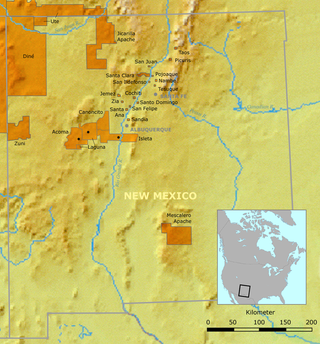
The Puebloans, or Pueblo peoples, are Native Americans in the Southwestern United States who share common agricultural, material, and religious practices. Among the currently inhabited Pueblos, Taos, San Ildefonso, Acoma, Zuni, and Hopi are some of the most commonly known. Pueblo people speak languages from four different language families, and each Pueblo is further divided culturally by kinship systems and agricultural practices, although all cultivate varieties of corn (maize).

Pueblo refers to the settlements and to the Native American tribes of the Pueblo peoples in the Southwestern United States, currently in New Mexico, Arizona, and Texas. The permanent communities, including some of the oldest continually occupied settlements in the United States, are called pueblos (lowercased).

The Eiteljorg Museum of American Indians and Western Art is an art museum in downtown Indianapolis, Indiana, United States. The Eiteljorg houses an extensive collection of visual arts by indigenous peoples of the Americas as well as Western American paintings and sculptures collected by businessman and philanthropist Harrison Eiteljorg (1903–1997). The museum houses one of the finest collections of Native contemporary art in the world.

Elbridge Ayer Burbank was an American artist who sketched and painted more than 1200 portraits of Native Americans from 125 tribes. He studied art in Chicago and in his 30s traveled to Munich, Germany, for additional studies with notable German artists. He is believed to be the only person to paint the war chief Geronimo from life.

The Institute of American Indian Arts (IAIA) is a public tribal land-grant college in Santa Fe, New Mexico, United States. The college focuses on Native American art. It operates the Museum of Contemporary Native Arts (MoCNA), which is housed in the historic Santa Fe Federal Building, a landmark Pueblo Revival building listed on the National Register of Historic Places as Federal Building. The museum houses the National Collection of Contemporary Indian Art, with more than 7,000 items.
The National Native American Hall of Fame, established in 2016 in Great Falls, Montana, with a working facility in Oklahoma City, Oklahoma, has the mission of 'honoring Native American achievements in contemporary society 1860's – present day', and was founded by Little Shell Chippewa James Parker Shield who now serves as chief executive officer after serving as Montana's State Coordinator of Indian Affairs as the first Native American in the staff of the Montana Governor's office. Founding partners include native polities the Navajo Nation, Yocha Dehe Wintun Nation, Chickasaw Nation and amici cultura the NoVo Foundation of Jennifer and Peter Buffett, daughter in law and son of Warren Buffett, and the TIDES Foundation founded by Drummond Pike.










